The Intrepid Sea, Air, and Space Museum is a military and maritime history museum at Pier 86 on the West Side of Manhattan. The museum opened in 1982 after the USS Intrepid was saved from scrapping. Later, the Intrepid became a National Historic Landmark in 1986. In 1988, the museum was awarded USS Growler, a Grayback-class submarine, which carried nuclear missiles by the United States Congress from the United States Navy and is now on display and available for tours. In 2011, ownership of the Space Shuttle Enterprise was transferred to the Intrepid Sea, Air & Space Museum.
The Intrepid Sea, Air & Space Museum is a nonprofit institution featuring the world’s fastest jets and a guided-missile submarine. The Museum exhibitions and collection feature the technologically advanced aircraft and vessels highlighting innovation and bravery. During 2001, the Intrepid served as temporary field headquarters for the Federal Bureau of Investigation as it began its investigation of the September 11 attacks.
The museum’s collection includes:
- U.S. Air Force fighter Aircraft
- U.S. Navy fighter Aircraft
- US Marine Corps fighting Aircraft
- U.S. Army helicopters
- U.S. Coast Guard helicopters
- NASA capsule replica and the Space Shuttle Enterprise
- Commercial Aircraft
- Non-USA Fighter Aircraft
- U.S. Navy Equipment from the USS Intrepid and other famous naval ships
A Tour of the Museum of the Intrepid, Sea, Air & Space Museum
- Concorde SST
- Space Shuttle Enterprise
- Grumman F-14 Tomcat
- British Aerospace AV-8C Harrier
- Bell UH-1 Iroquois (Huey)
- Bell AH-1J Sea Cobra
- Bell AH-1 SuperCobra
- Dassault Étendard IV M
- McDonnell F3H – 2N (F -3B) Demon
- Grumman (WF-2) E-1 Tracer
- Mikoyan-Gurevich MiG-17 / PZL-Mielec LIM-5
- Grumman F11F (F-11A) Tiger
- Grumman F9F-8 (AF-9J) Cougar
- Lockheed A-12
Grumman F-14 Tomcat

Grumman F-14 Tomcat
The Grumman F-14 Tomcat is a supersonic, twin-engine, two-seat, variable-sweep wing fighter aircraft. The F-14 was the first of the American fighters, which were designed incorporating air combat experience against MiG fighters during the Vietnam War.
The F-14 served as the U.S. Navy’s primary maritime air superiority fighter, fleet defense interceptor, and tactical aerial reconnaissance platform into the 1990s. The “Low Altitude Navigation and Targeting Infrared for Night” pod system was added in the 1990s, and the Tomcat began performing precision ground-attack missions.

In the 1980s, F-14s were used as land-based interceptors by the Islamic Republic of Iran Air Force during the Iran–Iraq War, where they saw combat against Iraqi warplanes. Iranian F-14s shot down approximately 160 Iraqi aircraft during the war. The F-14 remains in service with the Islamic Republic of Iran Air Force.
Grumman F-14 Tomcat
- Name: Grumman F-14 Tomcat
- Role: Interceptor, air superiority and multi-role combat aircraft
- National origin: United States
- Manufacturer: Grumman Aerospace Corporation
- First flight: 1970
- Introduction: 1974
- Retired by U.S.: 2006
- Produced: 1969–1991
- Number built: 712
- Unit cost: US$38 million (1998)
- Museum: Intrepid, Sea, Air & Space Museum
Bell AH-1J Sea Cobra

Bell AH-1J Sea Cobra
The Bell AH-1J Sea Cobra is a twin-engine attack helicopter which made its combat debut during the Vietnam War (1955 – 1975). The Cobra range is part of the larger Huey family.
The Sea Cobra on display is a veteran of Operation Desert Storm. It had a crew of two, a pilot and a gunner.
Bell AH-1J Sea Cobra
- Name: Bell AH-1J Sea Cobra
- Role: Attack helicopter
- Manufacturer: Bell Helicopter
- First flight: 1969
- Introduction: AH-1J: 1971, AH-1W: 1986
- Primary users:
- United States Marine Corps
- Islamic Republic of Iran Army
- Republic of China Army
- Turkish Army
- Produced: 1970–1980s
- Number built: 1,270 +
- Unit cost: AH-1W: US$10.7 million
- Museum: Intrepid, Sea, Air & Space Museum
Bell AH-1 SuperCobra

Bell AH-1 SuperCobra
The Bell AH-1 SuperCobra is a twin-engine attack helicopter that is part of the larger Huey family, which includes the SeaCobra and the SuperCobra. The SuperCobra helicopter fleet is being replaced by the next generation Bell AH-1Z Viper. The AH-1 Cobra was developed in the mid-1960s as an interim gunship for the U.S. Army for use during the Vietnam War. The Cobra shared the proven transmission, rotor system, and the turboshaft engine of the “Huey.”
During the Gulf War (August 1990 – February 1991), Marine SuperCobras were deployed and flew a total of 1,273 sorties in Iraq. The AH-1W units were credited with destroying 97 tanks, 104 armored personnel carriers and vehicles, and two anti-aircraft artillery sites during the 100-hour ground campaign. USMC Cobras also served in Afghanistan and the conflict in Iraq.

Bell AH-1 SuperCobra
- Name: Bell AH-1 SuperCobra
- Role: Attack helicopter
- Manufacturer: Bell Helicopter
- First flight: 1969
- Status: In-service
- Primary users: United States Marine Corps, Islamic Republic of Iran Army, Republic of China Army, Turkish Army
- Number built: 1,271+
- Unit cost: US$10.7 million
- Crew: two: pilot, co-pilot/gunner (CPG)
- Height: 13 ft 5 in (4.1 m)
- Maximum speed: 152 knots (175 mph, 282 km/h)
- Museum: Intrepid, Sea, Air & Space Museum
Bell UH-1 Iroquois (Huey)

Bell UH-1 Iroquois (Huey)
The Bell UH-1 Iroquois, nicknamed “Huey,” was a utility military helicopter that was developed to meet a United States Army’s need for a medical evacuation and utility helicopter and first flew in 1956.
The Iroquois was originally designated HU-1, hence the Huey nickname, which has remained in common use. The UH-1 first saw service in combat operations during the Vietnam War, with around 7,000 helicopters deployed.
The name “Iroquois” follows the U.S. Army’s tradition of using Native American names for helicopter designs.
Bell UH-1 Iroquois (Huey)
- Name: Bell UH-1 Iroquois (Huey)
- Role: Utility helicopter
- Manufacturer: Bell Helicopter
- First flight: 1956
- Introduction: 1959
- Primary users:
- United States Army
- Japan Ground Self-Defense Force
- Australian Army
- Produced: 1956–1987
- Number built: >16,000
- Museum: Intrepid, Sea, Air & Space Museum
McDonnell F3H – 2N (F -3B) Demon

McDonnell F3H – 2N (F -3B) Demon
The McDonnell F3H-2N (F-3B) Demon was a subsonic swept-wing U.S. Navy carrier-based jet fighter aircraft. It was withdrawn before it could serve in Vietnam.
The McDonnell F3H-2N (F-3B) Demon was designed to counter Russian MiG-15s and MiG-17s. Designed as a cannon and missile-carrying fighter, the aircraft’s large wings, with power-operated slats aided in providing lift at low speed, and give it smooth handling at high altitudes as well a good response during landings on carriers.
McDonnell F3H – 2N (F -3B) Demon
- Name: McDonnell F3H – 2N (F -3B) Demon
- Role: Carrier-based fighter aircraft
- Manufacturer: McDonnell Aircraft Corporation
- First flight: 1951
- Introduction: 1956
- Retired: 1964
- Primary user: United States Navy
- Number built: 519
- Museum: Intrepid, Sea, Air & Space Museum
Grumman (WF-2) E-1 Tracer

Grumman (WF-2) E-1 Tracer
The Grumman E-1 Tracer was the first purpose-built airborne early warning aircraft used by the U.S. Navy. Tracers were deployed on the “Intrepid” for operations off the coast of Vietnam.
Flying above a carrier task force, the Tracer and its crew of four provided an electronic bird’s eye view of the airspace. The radar capability of the Tracer extended the view of the task force many hundreds of miles over the horizon.

The Tracer served aboard the “Intrepid” until the ship’s retirement in 1974. The most distinctive feature of this airplane was the radome, the aerodynamic structure over the plane. The radome covered a dish-type radar system that had a search radius of 250 miles or 402 km.
Grumman (WF-2) E-1 Tracer
- Name: Grumman (WF-2) E-1 Tracer
- Role: Carrier Airborne early warning
- National origin: United States
- Manufacturer: Grumman
- First flight: 1956
- Introduction: 1958
- Retired: 1977
- Primary user: United States Navy
- Number built: 88
- Museum: Intrepid, Sea, Air & Space Museum
Grumman F11F (F-11A) Tiger
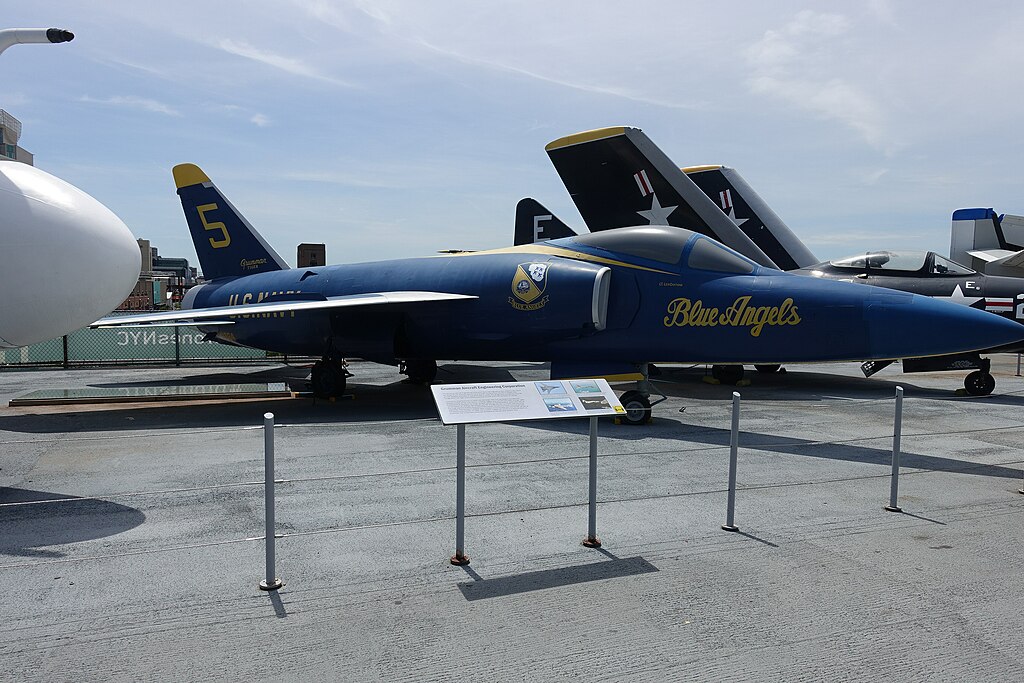
Grumman F11F (F-11A) Tiger
The Grumman F-11 Tiger was a supersonic, single-seat carrier-based U.S. Navy fighter aircraft. It featured a thin wing, fuselage-side intakes, a low-mounted tailplane, and an afterburning engine. The special fuselage shape was designed to reduce transonic and supersonic drag.
The Blue Angels, the U.S. Navy’s flight demonstration team, used the F11F/F-11 from 1957–1969. The plane on display served as Blue Angel #5.
Grumman F11F (F-11A) Tiger
- Name: Grumman F11F (F-11A) Tiger
- Role: Fighter aircraft
- Manufacturer: Grumman
- First flight: 1954
- Introduction: 1956
- Retired: 1961 (Carrier); 1969 (Blue Angels)
- Primary user: U.S. Navy
- Number built: 200
- Museum: Intrepid, Sea, Air & Space Museum
Grumman F9F-8 (AF-9J) Cougar
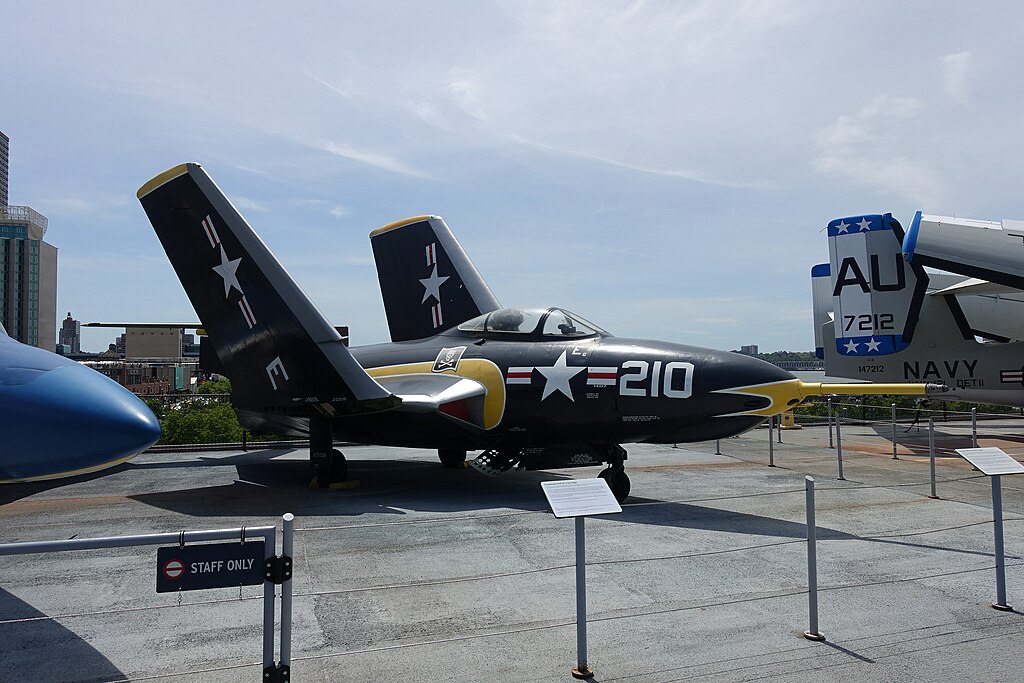
Grumman F9F-8 (AF-9J) Cougar
The Grumman F9F Cougar was an aircraft carrier-based fighter aircraft for the U.S. Navy and US Marine Corps. The F9F was known to be highly maneuverable and easy to fly.
Grumman F9F-8 (AF-9J) Cougar
- Name: Grumman F9F-8 (AF-9J) Cougar
- Role: Fighter aircraft
- National origin: United States
- Manufacturer: Grumman
- First flight: 1951
- Introduction: 1952
- Retired: 1974
- Primary users: U.S. Navy, US Marine Corps, Argentine Navy
- Number built: 1,988
- Museum: Intrepid, Sea, Air & Space Museum
Lockheed A-12

Lockheed A-12
The Lockheed A-12 was a reconnaissance aircraft built for the CIA by Lockheed’s Skunk Works. The plane was designated A-12, the 12th in a series for “Archangel,” the aircraft’s internal code name. The CIA selected Lockheed because it had produced the U-2 had experience running a “black” project.
The A-12 was produced from 1962 and flew until 1968. The program was officially revealed in the mid-1990s. It was the precursor to the SR-71 Blackbird, a slightly longer variant able to carry a heavier fuel and camera load. The crews named the A-12 the Cygnus to follow the Lockheed practice of naming aircraft after celestial bodies.

Before the A-12, titanium was used only in small parts directly related to supporting, cooling, or shaping high-temperature areas on aircraft like those subject to the highest kinetic heating from the airstream, such as wing leading edges. The A-12, however, was constructed mainly of titanium. Titanium is quite rigid and difficult to machine, which made it difficult to form into curves given available techniques. The solution was found by machining only small “fillets” of the material with the required shape and then gluing them onto the underlying framework, which was more linear.
Although initially designed to succeed the U-2 in overflights over the Soviet Union and Cuba, the A-12 was never used for either role. After a U-2 was shot down in 1960, the Soviet Union was considered too dangerous to overfly except in an emergency, and overflights were no longer necessary, thanks to reconnaissance satellites.
The CIA decided to deploy some A-12s to Asia, and it began Operation Black Shield operations over North Vietnam, photographing surface-to-air missile (SAM) sites, flying at 80,000 ft (24,000 m), and at about Mach 3.1. During 1967, the A-12s carried out 22 sorties in support of the Vietnam War. During 1968 further Black Shield operations were conducted in Vietnam. Sorties were also carried out during the Pueblo Crisis with North Korea. Six of the 15 A-12s were lost in accidents, with the loss of two pilots and one engineer.
Lockheed A-12
- Name: Lockheed A-12
- Role: High-altitude reconnaissance aircraft
- Manufacturer: Lockheed Corporation
- First flight: 1962
- Retired: 1968
- Primary user: Central Intelligence Agency – CIA
- Developed into: Lockheed SR-71 Blackbird
- Maximum speed: Mach 3.35
- Crew: 1
- Length: 101 ft 7 in (30.96 m)
- Wingspan: 55 ft 7 in (16.94 m)
- Height: 18 ft 6 in (5.64 m)
- Wing area: 1,795 sq ft (166.8 m2)
- Museum: Intrepid, Sea, Air & Space Museum
Space Shuttle Enterprise
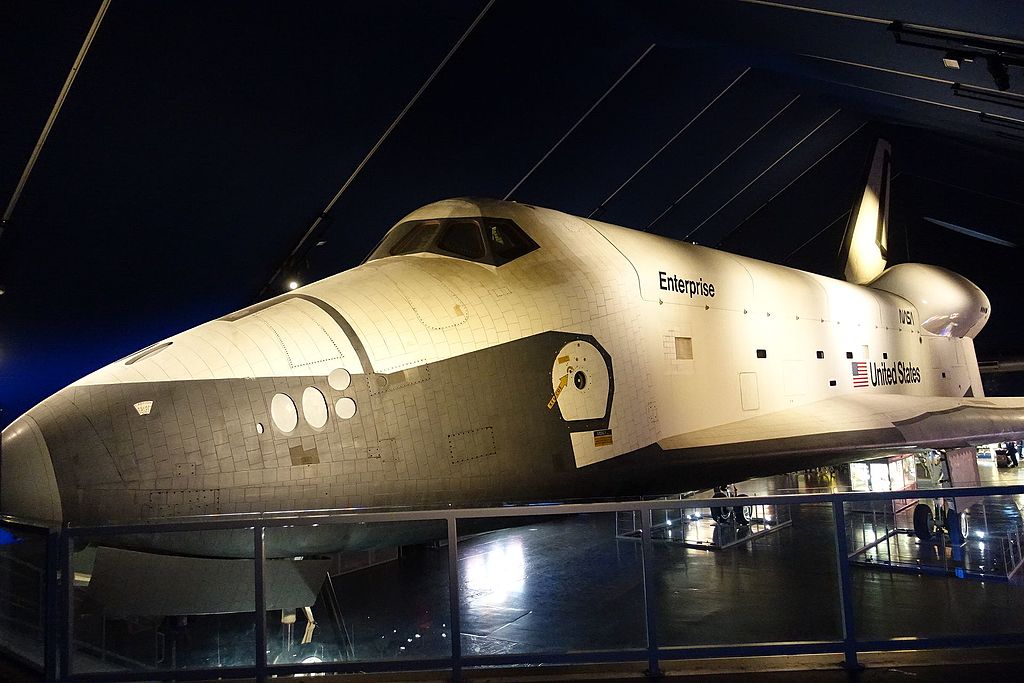
Space Shuttle Enterprise
The Space Shuttle “Enterprise” was the first orbiter of the Space Shuttle system. It was built in 1976 for NASA as part of the Space Shuttle program to perform atmospheric test flights after being launched from a modified Boeing 747. It was constructed without engines or a functional heat shield and was therefore not capable of spaceflight.

The Space Shuttle system was composed of an orbiter launched with two reusable solid rocket boosters and a disposable external fuel tank. It was capable of carrying up to eight astronauts and up to 50,000 lb (23,000 kg) of payload into low Earth orbit (LEO). When its mission was complete, the orbiter would re-enter the Earth’s atmosphere and land like a glider.

The Enterprise, as the first experimental orbiter, was a high-altitude glider launched from the back of a specially modified Boeing 747, only for initial atmospheric landing tests (ALT). Enterprise’s first test flight was in 1977, five years after the Shuttle program was initiated. This led to the launch of the first space-worthy shuttle Columbia in 1981. The Space Shuttle program finished with its last mission, flown by Atlantis, in 2011.
“Enterprise,” was initially to be named “Constitution” to honor the Constitution of the United States. However, “Star Trek” fans started a massive write-in campaign urging the White House to name the first of the Space Shuttle after the original starship “USS Enterprise” from the “Star Trek” T.V. series. Then-president Gerald Ford got tens of thousands of these letters. Following this campaign, President Gerald Ford directed NASA officials to change the name, saying he was “partial to the name” Enterprise.

Star Trek creator and cast attending Enterprise’s rollout ceremony in 1976
Space Shuttle Enterprise
- Name: Space Shuttle Enterprise
- Named after: USS Enterprise (NCC-1701) (Star Trek starship)
- Status: Retired, on display at Intrepid Museum, New York City
- Built: 1976
- Built by: Rockwell International
- First flight: 1977
- Last flight: 2012
- Time in space: Never flew in space
- Museum: Intrepid, Sea, Air & Space Museum
British Aerospace AV-8C Harrier

British Aerospace AV-8C Harrier
Most aircraft require long runways or an aircraft carrier’s powerful catapults to get airborne. This British-designed Harrier “Jump Jet” used vectored-thrust technology to take-off and land vertically. The British Aerospace Harrier was capable of vertical or short takeoff and landing (V/STOL).
The first Harrier flew for the British Royal Navy (R.N.) in 1967 and saw combat during the Falkland War in 1982. The Harrier II participated in numerous conflicts, making significant contributions in combat theatres such as Kosovo, Iraq, and Afghanistan.
The US Marine Corps realized the Harrier’s potential and purchased Harriers from Britain in 1970 -71. The aircraft in the picture above was part of the Marine Corps original order of Harrier Mk Is. It was upgraded with more powerful engines and electronics and designated A.V. – 8C.
The McDonnell Douglas (now Boeing) AV-8B Harrier II was a single-engine ground-attack aircraft that was the second generation of the Harrier Jump Jet family. The AV-8B was used by the United States Marine Corps (USMC), the Spanish Navy, and the Italian Navy.
The Harrier’s unique ability to land and takeoff vertically ensured it was featured in films such as the James Bond “The Living Daylights” (1987) and “True Lies” (1994)
British Aerospace AV-8C Harrier
- Name: British Aerospace Harrier
- Role: Vertical/short takeoff and landing strike aircraft
- National origin: United Kingdom / United States
- Manufacturer: British Aerospace / McDonnell Douglas, BAE Systems / Boeing
- First flight: 1967 (first version)
- Introduction: 1980’s
- Unit cost: US$24–30 million (1996)
- Developed from: Hawker Siddeley Harrier; McDonnell Douglas AV-8B Harrier II
- Museum: Intrepid, Sea, Air & Space Museum
Concorde SST

Concorde SST
The Concorde SST (SuperSonic Transport) is a civilian supersonic aircraft designed to transport passengers at speeds greater than the speed of sound. The Concorde was a turbojet-powered supersonic passenger jet airliner that was operated until 2003. It had a maximum speed over twice the speed of sound at Mach 2.04 (1,354 mph or 2,180 km/h at cruise altitude).
First flown in 1969, Concorde entered commercial service in 1976 and continued flying for 27 years. It is one of only two supersonic transports to have been operated commercially. The only other SuperSonic Transport was the Soviet-built Tupolev Tu-144.
The development of the Concorde was made with many technological breakthroughs, jointly by Sud and the British Aircraft Corporation under an Anglo-French treaty. Only twenty aircraft were built as only Air France and British Airways purchased and flew the Concorde. The aircraft was used by wealthy passengers who could afford to pay a high price for Concorde’s speed and luxury service. It flew its scheduled routes in less than half the time of other airliners.
As aircraft development evolved, subsonic aircraft with larger capacity and more fuel-efficient designs, such as the Airbus A380 and the Boeing 787 Dreamliner was seen as the future. Thus, with the downturn in the commercial aviation industry after the September 11 attacks in 2001, the Concorde operations ceased in 2003. Surviving aircraft were given to museums in Britain, France, and the USA.
Concorde SST
- Name: Concorde
- Role: Supersonic passenger transport
- National origin: United Kingdom and France
- Manufacturer
- BAC (later BAe and BAE Systems) &
- Sud Aviation (later Aérospatiale and EADS)
- First flight: 1969
- Introduction: 1976
- Retired: 2003
- Produced: 1965–1979
- Number built: 20
- Unit cost: £23 million in 1977
- Museum: Intrepid, Sea, Air & Space Museum
Dassault Étendard IV M
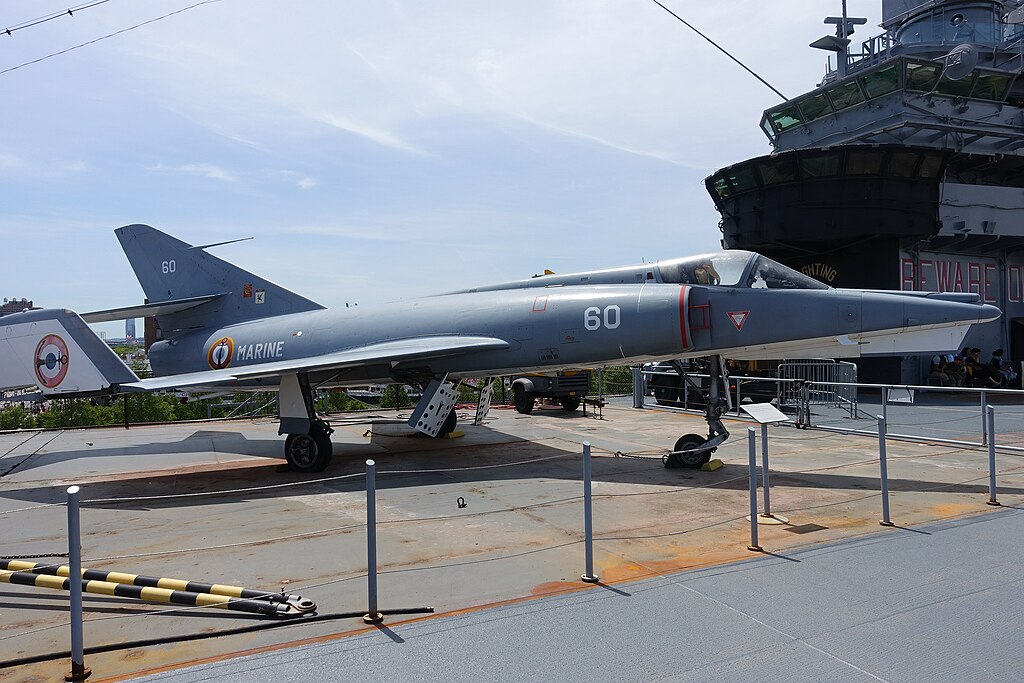
Dassault Étendard IV M
The Dassault Étendard IV was a subsonic carrier-borne strike fighter aircraft. Étendard means battle-standard or battle-flag in French. The “M” stands for the Marine, the French name for Navy.
Iraq flew the improved Super Étendard in the Iran-Iraq War (1980 – 88) and by Argentina in the Falklands War (1982).
Dassault Étendard IV M
- Name: Dassault Étendard IV M
- Role: Strike fighter
- National origin: France
- Manufacturer: Dassault Aviation
- First flight: 1958
- Introduction: 1962
- Retired: 1991
- Primary user: French Navy
- Number built: 90
- Museum: Intrepid, Sea, Air & Space Museum
Mikoyan-Gurevich MiG-17 / PZL-Mielec LIM-5

Mikoyan-Gurevich MiG-17 / PZL-Mielec LIM-5
The Mikoyan-Gurevich MiG-17 is a high-subsonic fighter aircraft produced in the USSR from 1952 and operated by numerous air forces in many variations. The MiG-17 built on the success of the Soviet MiG-15 in the Korean War (1950 – 1953).
The MiG-17 proved to be an effective threat against the supersonic fighters of the U.S. in the Vietnam War (1955 – 1975). The MiG-17’s maneuverability and cannon armament proved legendary in Vietnam War dogfights.
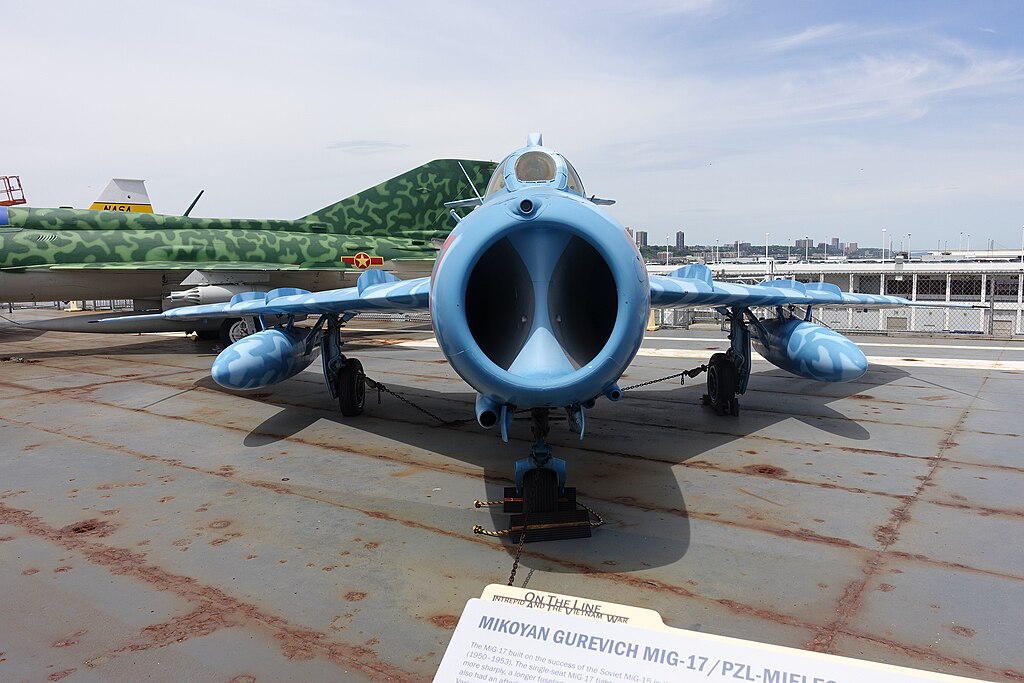
The Lim-5 was a Polish attack aircraft used by the Polish Air Force. It was a variant of the Mikoyan-Gurevich MiG-17. The aircraft on display is the Polish-built PZL-Mielec LIM-5 painted in the camouflage of a MiG-17 of the Vietnamese Air Force.
Mikoyan-Gurevich MiG-17 / PZL-Mielec LIM-5
- Name: Mikoyan-Gurevich MiG-17 / PZL-Mielec LIM-5
- Russian: Микоян и Гуревич МиГ-17
- NATO reporting name: Fresco
- China: Shenyang J-5
- Poland: PZL-Mielec Lim-5
- Role: Fighter aircraft
- National origin: Soviet Union
- Manufacturer: Mikoyan-Gurevich
- First flight: 1950
- Introduction: 1952
- Primary users: Soviet Air Force; PLA Air Force; Polish Air Force; Vietnam People’s Air Force
- Number built: 11,060
- Museum: Intrepid, Sea, Air & Space Museum
Visiting Tips for Intrepid Sea, Air and Space Museum
- All bags and cases will be inspected before entry.
- Bag and coat check facilities are NOT available. Leave large bags and luggage at your hotel.
- Wear comfortable clothing and shoes.
- Avoid items that can get caught while climbing in and out of exhibits.
- Visit on a dry day, as during inclement weather, the Museum may close the flight deck and Space Shuttle Pavilion for the safety of visitors.
- Food options are available.
Intrepid Sea, Air and Space Museum
- Name: Intrepid, Sea, Air & Space Museum
- City: New York
- Country: United States
- Established: 1982
- Type: Military History Museum
- Address: 12th Avenue and 46th Street, Manhattan, New York City, U.S.
Explore Military, War, Spy, Air, Space, Maritime, Science and Technology Museums
Military and War Museums
- Imperial War Museum, London
- Intrepid, Sea, Air & Space Museum, New York
- Australian War Memorial
- Darwin Military Museum
- Shrine of Remembrance, Melbourne, Australia
- Changi Museum
- War Museum of Thessaloniki
Spy Museums
- International Spy Museum
Air and Space Museums
- National Air and Space Museum
- Intrepid, Sea, Air & Space Museum
Maritime Museums
- Australian National Maritime Museum
- New Zealand Maritime Museum
- Queensland Maritime Museum
- WA Maritime Museum
- WA Shipwrecks Museum
- Intrepid, Sea, Air & Space Museum, New York
- USS Cod
Science and Technology Museums
- Science Museum, London
- Queensland Museum & Science Center
- National Museum of Nature and Science, Tokyo
- ArtScience Museum, Singapore
- Shanghai Science and Technology Museum
- Great Lakes Science Center, Cleveland
- Intrepid, Sea, Air & Space Museum, New York
- National Air and Space Museum, Washington DC
- National Museum of Nature and Science, Tokyo
~~~
“We must all hang together, or assuredly we shall all hang separately.”
– Benjamin Franklin
~~~
Photo Credit: By Ad Meskens (Own work) [Copyrighted free use, CC BY-SA 3.0 (http://creativecommons.org/licenses/by-sa/3.0) or GFDL (http://www.gnu.org/copyleft/fdl.html)], via Wikimedia Commons
Popular this Week








 Sponsor your Favorite Page
Sponsor your Favorite Page SEARCH Search for: Search Follow UsJoin – The JOM Membership Program
Sponsor a Masterpiece with YOUR NAME CHOICE for $5
Share this:
- Tweet

